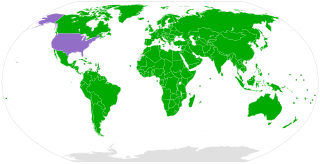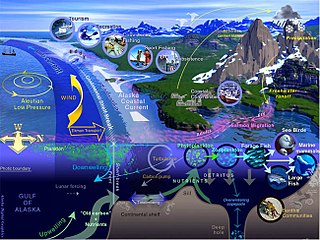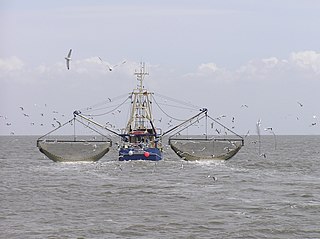This article does not cite any sources .(August 2018) (Learn how and when to remove this template message) |
Aquatic biodiversity research is the field of scientific research studying marine and freshwater biological diversity.
This article does not cite any sources .(August 2018) (Learn how and when to remove this template message) |
Aquatic biodiversity research is the field of scientific research studying marine and freshwater biological diversity.
After the Earth Summit in Rio, 1992 and the adoption of the Convention on Biological Diversity, the term biodiversity has become a component of research policy in many countries and international bodies and initiatives. Biodiversity however, is not a concept but an umbrella term (Haila and Kouki 1994); the content of which is quite diverse as can be inferred by definitions provided in many different texts (Wilson 1988, Reid and Miller 1989, CBD 1992, Margalef 1997). The distinction between diversity and biodiversity is also fairly unclear in many studies in biology. As with most other issues in Ecology and Evolution, paradigms dominating the study of biodiversity on both global and regional scales come mainly from the terrestrial environment despite the marked distinctive features of marine biodiversity and the fact that the aquatic (freshwater & marine) environment occupies more than two thirds of the Earth’s surface (Vanaverbeke et al. 1997, Gessner et al. 2004). Marine organisms play crucial roles in many bio-geochemical processes that sustain the biosphere, and provide a variety of products and functions which are essential to mankind’s well-being, including the production of food and natural substances, the assimilation of waste and regulation of the world’s climate. The rate and efficiency of any processes that marine organisms mediate, as well as the range of goods and services that they provide, are determined by interactions between organisms and interactions between organisms and their environment; and therefore by biodiversity (Gaston 1996, Gaston and Spicer 1998). These relationships have not yet been quantified, and we are at present unable to predict the consequences of loss of biodiversity resulting from environmental change in ecological, economic or social terms (Walker, 1992, Lawton and Brown, 1994, Ehrlich and Ehrlich, 1981, Lawton, 1994, Vitousek and Hooper 1994). The influence of species diversity on the productivity of marine ecosystems on a large scale is still unclear (Cardinale et al. 2004).

The United Nations Conference on Environment and Development (UNCED), also known as the Rio de Janeiro Earth Summit, the Rio Summit, the Rio Conference, and the Earth Summit, was a major United Nations conference held in Rio de Janeiro from 3 to 14 June 1992.

The Convention on Biological Diversity (CBD), known informally as the Biodiversity Convention, is a multilateral treaty. The Convention has three main goals including: the conservation of biological diversity ; the sustainable use of its components; and the fair and equitable sharing of benefits arising from genetic resources.

Biodiversity refers to the variety and variability of life on Earth. Biodiversity typically measures variation at the genetic, species, and ecosystem level. Terrestrial biodiversity is usually greater near the equator, which is the result of the warm climate and high primary productivity. Biodiversity is not distributed evenly on Earth, and is richest in the tropics. These tropical forest ecosystems cover less than 10 percent of earth's surface, and contain about 90 percent of the world's species. Marine biodiversity is usually highest along coasts in the Western Pacific, where sea surface temperature is highest, and in the mid-latitudinal band in all oceans. There are latitudinal gradients in species diversity. Biodiversity generally tends to cluster in hotspots, and has been increasing through time, but will be likely to slow in the future.
Terrestrial paradigms do not necessarily apply to marine biota. Our understanding of the role and regulation of aquatic biodiversity lies far behind that of terrestrial biodiversity, to such an extent that we do not have enough scientific information to underpin management issues such as conservation and sustainable use of marine resources. Many of these paradigms may not be applicable to the marine situation because of differences to terrestrial ecosystems (Heip et al. 1998, Gessner et al. 2004). A greater variety of species at a higher trophic level are exploited in the sea than on land. Exploitation of marine biodiversity is also far less managed than on land (Heip et al. 1998, Giller et al. 2004). Environmental change in the sea has a much lower frequency than on land, both temporally and spatially. Marine systems are more open than terrestrial and dispersal of species may occur over much broader ranges than on land (Heip et al. 1998). The main marine primary producers are very small and often mobile, whereas on land primary producers are large and static. The standing stock of grazers is higher than that of primary producers in the sea, the reverse of the situation on land. In the largest part of the ocean, beneath the shallow surface layers, no photosynthesis occurs at all (Heip et al. 1998, Giller et al. 2004). In addition, pollution from the air, land and freshwater ultimately enters the sea and therefore marine biodiversity is most exposed to, and critically influences the fate of, pollutants in the world (Heip et al. 1998). Published research affects decision making on conservation of biodiversity. Conservation measures taken for biodiversity of an area depend also on the areas ecological, economic and social importance, as evaluated by science and society (Wackernagel et al. 1999, Constanza 1997, CDB 1992). On the other hand, while conservation measures are usually taken for some species, there are several cases where species of virtually no commercial value become extinct almost unnoticed (Casey and Myers 1998).

The trophic level of an organism is the position it occupies in a food chain. A food chain is a succession of organisms that eat other organisms and may, in turn, be eaten themselves. The trophic level of an organism is the number of steps it is from the start of the chain. A food chain starts at trophic level 1 with primary producers such as plants, can move to herbivores at level 2, carnivores at level 3 or higher, and typically finish with apex predators at level 4 or 5. The path along the chain can form either a one-way flow or a food "web". Ecological communities with higher biodiversity form more complex trophic paths.

Marine biology is the scientific study of marine life, organisms in the sea. Given that in biology many phyla, families and genera have some species that live in the sea and others that live on land, marine biology classifies species based on the environment rather than on taxonomy.

An ecoregion is an ecologically and geographically defined area that is smaller than a bioregion, which in turn is smaller than an ecozone. All three of these are either less or greater than an ecosystem. Ecoregions cover relatively large areas of land or water, and contain characteristic, geographically distinct assemblages of natural communities and species. The biodiversity of flora, fauna and ecosystems that characterise an ecoregion tends to be distinct from that of other ecoregions. In theory, biodiversity or conservation ecoregions are relatively large areas of land or water where the probability of encountering different species and communities at any given point remains relatively constant, within an acceptable range of variation.

Fresh water is any naturally occurring water except seawater and brackish water. Fresh water includes water in ice sheets, ice caps, glaciers, icebergs, bogs, ponds, lakes, rivers, streams, and even underground water called groundwater. Fresh water is generally characterized by having low concentrations of dissolved salts and other total dissolved solids. Though the term specifically excludes seawater and brackish water, it does include mineral-rich waters such as chalybeate springs.

An ecosystem engineer is any organism that creates, significantly modifies, maintains or destroys a habitat. These organisms can have a large impact on the species richness and landscape-level heterogeneity of an area. As a result, ecosystem engineers are important for maintaining the health and stability of the environment they are living in. Since all organisms impact the environment they live in in one way or another, it has been proposed that the term "ecosystem engineers" be used only for keystone species whose behavior very strongly affects other organisms.

Grazing is a method of feeding in which a herbivore feeds on plants such as grasses, or other multicellular organisms such as algae. In agriculture, grazing is one method used whereby domestic livestock are used to convert grass and other forage into meat, milk and other products.
Species richness is the number of different species represented in an ecological community, landscape or region. Species richness is simply a count of species, and it does not take into account the abundances of the species or their relative abundance distributions. Species diversity takes into account both species richness and species evenness.

Marine life, or sea life or ocean life, is the plants, animals and other organisms that live in the salt water of the sea or ocean, or the brackish water of coastal estuaries. At a fundamental level, marine life affects the nature of the planet. Marine organisms produce oxygen. Shorelines are in part shaped and protected by marine life, and some marine organisms even help create new land.
Species richness, or biodiversity, increases from the poles to the tropics for a wide variety of terrestrial and marine organisms, often referred to as the latitudinal diversity gradient (LDG). The LDG is one of the most widely recognized patterns in ecology. The LDG has been observed to varying degrees in Earth's past. A parallel trend has been found with elevation, though this is less well-studied

The Guanacaste Conservation Area is an administrative area which is managed by the Sistema Nacional de Areas de Conservacion (SINAC) of Costa Rica for the purposes of conservation in the northwestern part of Costa Rica. It contains three national parks, as well as wildlife refuges and other nature reserves. The area contains the Area de Conservación Guanacaste World Heritage Site, which comprises four areas.

Papua New Guinea together with the West Papua region of Indonesia make up a major tropical wilderness area that still contains 5% of the original and untouched tropical high-biodiversity terrestrial ecosystems. PNG in itself contains over 5% of the world's biodiversity in less than 1% of the world's total land area. The flora of New Guinea is unique because it has two sources of origin" The Gondwana flora from the south and flora with Asian origin from the west, as a result New Guinea shares major family and genera with Australia and the East Asia, but is rich in local endemic species. The endemicity is a result of mountainous isolation, topographic and soil habitat heterogeneity, high forest disturbance rates and abundant aseasonal rainfall year-round. PNG boasts some 15-21,000 higher plants, 3,000 species of orchids, 800 species of coral, 600 species of fish, 250 species of mammals and 760 species of birds and 8 species of tree-kangaroos out of which 84 genera of animals are endemic. Ecosystems range from lowland forests to montane forests, alpine flora down to coastal areas which contains some of the most extensive pristine mangrove areas in the world. Much of this biodiversity has remained intact for thousands of years because the ruggedness of the terrain made the interior lands inaccessible; furthermore low population density and restrictions on the effectiveness of traditional tools, ensured that these biodiversity was never overexploited.

Cross-boundary subsidies are caused by organisms or materials that cross or traverse habitat patch boundaries, subsidizing the resident populations. The transferred organisms and materials may provide additional predators, prey, or nutrients to resident species, which can affect community and food web structure. Cross-boundary subsidies of materials and organisms occur in landscapes composed of different habitat patch types, and so depend on characteristics of those patches and on the boundaries in between them. Human alteration of the landscape, primarily through fragmentation, has the potential to alter important cross-boundary subsidies to increasingly isolated habitat patches. Understanding how processes that occur outside of habitat patches can affect populations within them may be important to habitat management.

Marine invertebrates are the invertebrates that live in marine habitats. Invertebrate is a blanket term that includes all animals apart from the vertebrate members of the chordate phylum. Invertebrates lack a vertebral column, and some have evolved a shell or a hard exoskeleton. As on land and in the air, marine invertebrates have a large variety of body plans, and have been categorised into over 30 phyla. They make up most of the macroscopic life in the oceans.

A fishery is an area with an associated fish or aquatic population which is harvested for its commercial value. Fisheries can be marine (saltwater) or freshwater. They can also be wild or farmed.

The Coral Triangle is a geographical term so named as it refers to a roughly triangular area of the tropical marine waters of Indonesia, Malaysia, Papua New Guinea, Philippines, Solomon Islands and Timor-Leste that contain at least 500 species of reef-building corals in each ecoregion. This region encompasses portions of two biogeographic regions: the Indonesian-Philippines Region, and the Far Southwestern Pacific Region. The Coral Triangle is recognized as the global centre of marine biodiversity and a global priority for conservation. It is also called the "Amazon of the seas" and covers 5.7 million square kilometres (2,200,000 sq mi) of ocean waters. Its biological resources sustain the lives of over 120 million people.
According to the Coral Triangle Knowledge Network, about $3 billion in fisheries exports and another $3 billion in coastal tourism revenues are derived as annual foreign exchange income in the region.

Euthyneura is a taxonomic clade of snails and slugs, which includes species from freshwater, marine, aquatic and terrestrial gastropod mollusks in the clade Heterobranchia.

Cu Lao Cham Marine Park also known as Cham Islands Biosphere Reserve is part of the eight islets of the Chàm Islands, located in the South China Sea under the administration of Tân Hiệp Commune and Hội An town, in Quảng Nam Province, Vietnam. The terrestrial and coastal ecosystems of the islands have been recognized as a global Biosphere Reserve by UNESCO on 26 May 2009 under its 'Man and the Biosphere Programme' for its rich biodiversity value. The eco system also includes the ancient Hội An, which is 20 kilometres (12 mi) away from the islands, a UNESCO World Heritage Site.
The Key Biodiversity Areas (KBA) approach helps to identify and designate areas of international importance in terms of biodiversity conservation using globally standardised criteria. KBAs extend the Important Bird Area (IBA) concept to other taxonomic groups and are now being identified in many parts of the world, by a range of organisations. Examples include Important Plant Areas (IPAs), Ecologically and Biologically Significant Areas (EBSAs) in the High Seas, Alliance for Zero Extinction (AZE) sites, Prime Butterfly Areas, Important Mammal Areas and Important Sites for Freshwater Biodiversity, with prototype criteria developed for freshwater molluscs and fish and for marine systems. The determination of KBAs often brings sites onto the conservation agenda that hadn't previously been identified as needing protection due to the nature of the two non-exclusive criteria used to determine them; vulnerability; and irreplaceability
Marine microorganisms are defined by their habitat as the microorganisms living in a marine environment, that is, in the saltwater of a sea or ocean or the brackish water of a coastal estuary. A microorganism is any microscopic living organism, that is, any life form too small for the naked human eye to see, needing a microscope. Microorganisms are very diverse. They can be single-celled or multicellular and include all bacteria and archaea and most protozoa, as well as some species of fungi, algae, and certain microscopic animals, such as rotifers. Many macroscopic animals and plants have microscopic juvenile stages. Some microbiologists also classify viruses as microorganisms, but others consider these as nonliving. In July 2016, scientists reported identifying a set of 355 genes from the last universal common ancestor (LUCA) of all life, including microorganisms, living on Earth.

Environmental DNA or eDNA is DNA that is collected from a variety of environmental samples such as soil, seawater, snow or even air rather than directly sampled from an individual organism. As various organisms interact with the environment, DNA is expelled and accumulates in their surroundings. Example sources of eDNA include, but are not limited to, feces, mucus, gametes, shed skin, carcasses and hair. Such samples can be analyzed by high-throughput DNA sequencing methods, known as metagenomics, metabarcoding, and single-species detection, for rapid measurement and monitoring of biodiversity. In order to better differentiate between organisms within a sample, DNA metabarcoding is used in which the sample is analyzed and uses previously studied DNA libraries to determine what organisms are present. The analysis of eDNA has great potential, not only for monitoring common species, but to genetically detect and identify other extant species that could influence conservation efforts. This method allows for biomonitoring without requiring collection of the living organism, creating the ability to study organisms that are invasive, elusive, or endangered without introducing anthropogenic stress on the organism. Access to this genetic information makes a critical contribution to the understanding of population size, species distribution, and population dynamics for species not well documented. The integrity of eDNA samples is dependent upon its preservation within the environment. Soil, permafrost, freshwater and seawater are well-studied macro environments from which eDNA samples have been extracted, each of which include many more conditioned subenvironments. Because of its versatility, eDNA is applied in many subenvironments such as freshwater sampling, seawater sampling, terrestrial soil sampling, aquatic soil sampling, or other environments where normal sampling procedures can become problematic.